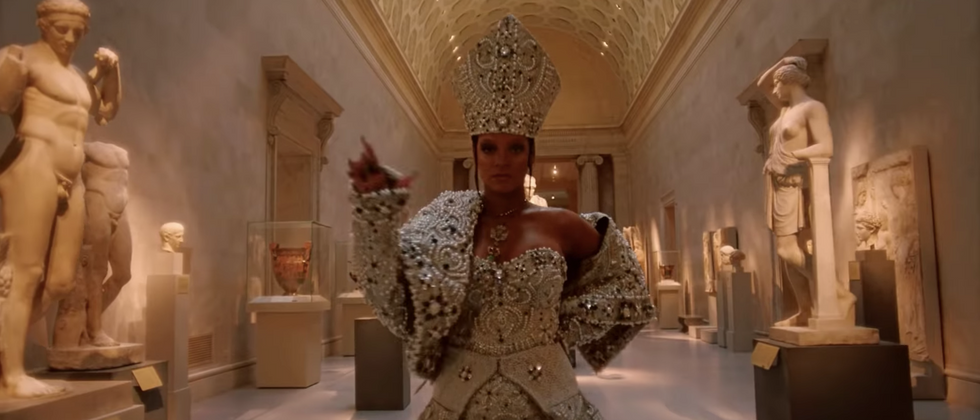On Monday, May 7th, the biggest fashion event of the year rolled around again, leaving our jaws dropped, our wigs snatched, and unfortunately, some conservative Catholics reeled up. Hosted by Vogue editor Anna Wintour, the Costume Institute Gala, better known as the Met Gala, is an annual fundraising event for the Metropolitan Museum of Art’s Costume Institution, which has been a focal point for the media every year that it comes around.
Described by fashion king Andre Leon Talley as “the Super Bowl of fashion,” A-list celebrities from Blake Lively to Elon Musk occupy the grand red carpet decked out in the world’s most respected designers like Margiela, Versace, and Vera Wang.
Throughout the years, Wintour has chosen a theme for the celebs to dress to, some past events being “Jacqueline Kennedy: The White House Years,” in 2002, “Punk: Chaos to Couture” in 2013, and most recently in 2017 “Comme Des Garcons: The Art of the In Between.” The themes are left up to the creativity and interpretation of the stylist and celebrities, making the event a multilayered event of fashion analysis.
This year, the theme was announced without much fuss, but in the wake of Monday night is raising eyebrows and conversations about the idea of cultural appropriation. “Heavenly Bodies: Fashion and the Catholic Imagination” was what Wintour chose, saying the theme was “designed to create a dialogue between fashion and the masterworks of religious art in the museum’s holdings,” and “highlight the enduring influence of religion and liturgical vestments on fashion.”
In a world of increased sensitivity and political correctness, people came forward to speak up against the theme, claiming it was cultural appropriation and offensive to those who identify with the Catholic church. There was an argument of “double standards,” as just a week earlier a Caucasian girl had been skewered on Twitter for wearing a Chinese Cheongsam to her prom, but people weren’t upset about Rihanna’s Pope-inspired outfit and Mitre.
A Catholic website, catholicvote.org called the “use of religious iconography for the costumes and accessories of scantily-clad celebs" "inappropriate at best and blasphemous at worst,” claiming the theme and costumes were offensive and exceedingly ignorant. While the idea of a double standard can be alive and well in society when it comes to cultural appropriation with celebrities like the Jenner’s, Katy Perry, and Selena Gomez, preaching against appropriation and then practicing it, this is not the case with the 2018 Met Gala.
For starters, religion and culture are two different things. Culture is defined as the “ideas, customs, and social behavior of a particular people,” and given Catholicism is not practiced by one “people” or group, the idea that what occurred was cultural appropriation is wrong.
In addition, a principle characteristic of cultural appropriation is the adaptation of cultural aspects from a widely marginalized culture, which if Catholicism was a culture, it would not be a marginalized one. While the argument against cultural appropriation at the Met really could end there, it’s also important to understand the Church’s participation in the event itself.
The Pontifical Council for Culture, a council based in the Vatican in charge of fostering the relationship between the Catholic Church and different cultures chose to collaborate with the Metropolitan Museum of Art in an attempt to encourage global outreach of the church. The Archbishop of New York, Timothy Cardinal Dolan was in attendance, and defended the event, saying “the Church and ‘the Catholic imagination’ are all about truth, goodness, and beauty…”
That’s why the church wants to support the MET Gala theme: to celebrate fashion and “thank God for beauty.” The Vatican supported the event wholly, even going so far as to donate 40 pieces from the Sistine Chapel, all of which had never previously left Rome, according to the New York Times.
In addition to the support of the Church, many of the celebrities, and possibly even more importantly, the designers of their costumes, identify as Catholic. Dolce & Gabbana, the creators of Sarah Jessica Parkers gold nativity scene number, are “devoted, observant Catholics,” who “grew up with the church imagery,” and had “a lot of strong feelings and beautiful sketches” in anticipation for the event, the actress revealed in an interview with E! News.
Other designers like Yves Saint Laurent, John Galliano, and Prada all have Catholic roots and have fostered religious imagery in their pieces long before the Met Gala event.
At the end of the day, this entire situation would be different if the Met Gala was blatant cultural appropriation, but given that it clearly isn't, we can take the time to appreciate not only the art of fashion and its leading designers work, but also the beauty and imagery of the Catholic church.
Anna Wintour truly went above and beyond this year with her theme, weaving together incredible fashion and the history and art of the Catholic church, all while educating and honoring the meaning of every married aspect of religion and arts.



































